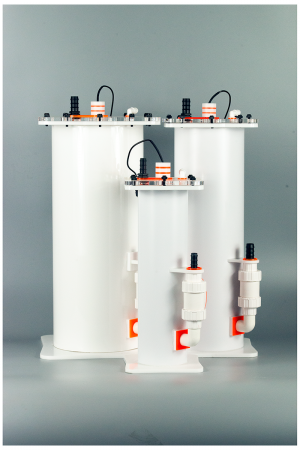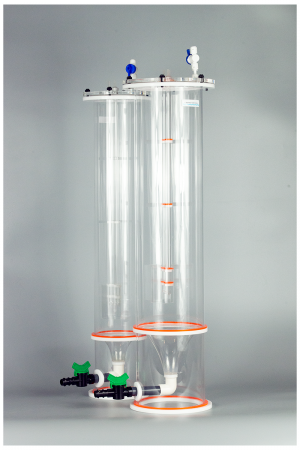Algae reactors for natural filtration – quickly remove nitrate and phosphates from water.
An algae bioreactor is used for cultivating micro or macro algae. Algae may be cultivated for the purposes of biomass production (as in a seaweed cultivator), wastewater treatment, CO2 fixation, or aquarium/pond filtration in the form of an algae scrubber. Algae bioreactors vary widely in design, falling broadly into two categories: open reactors and enclosed reactors. Open reactors are exposed to the atmosphere while enclosed reactors, also commonly called photobioreactors, are isolated to varying extent from the atmosphere. Specifically, algae bioreactors can be used to produce fuels such as biodiesel and bioethanol, to generate animal feed, or to reduce pollutants such as NOx and CO2 in flue gases of power plants. Fundamentally, this kind of bioreactor is based on the photosynthetic reaction which is performed by the chlorophyll-containing algae itself using dissolved carbon dioxide and sunlight energy. The carbon dioxide is dispersed into the reactor fluid to make it accessible for the algae. The bioreactor has to be made out of transparent material.
The algae are photoautotroph organisms which perform oxygenic photosynthesis.
Algae reactors
Showing all 3 results
-
Algae reactors
Algae Reactor AR-PRO
The Algae reactor is a simple and effective natural nutrient control method that helps promote a healthy and thriving reef tank.
[Product technical details below description]
The AR-Pro series incorporates a unique design that allows macro algae such as Chaetomorpha to grow with great yields, leading to the effective nutrient export of unwanted nitrates and phosphates.
In addition to nutrient control, the use of AR-PRO algae reactor provides other benefits such as the consumption of excess CO2 and elevation of oxygen levels in the aquarium.
Recommended to be used on a reverse daylight cycle, helping to balance pH swings and create a stable environment for the tank inhabitants.
Key factors:
-NO3 reduction
-PO4 reduction
-Dissolved Organics reduction
-Carbon dioxide reduction
-Increased Oxygen Levels
-Increase and stabilise pH
-Increased Redox levels
-Improve water quality
-Speed up corals calcification
-Helps create healthy natural conditions for all aquarium inhabitants.
-Replaces other methods of nutrient control such as Carbon Dosing and Bio-Pellets with a natural solution.Manual for – and how it works: https://pacific-sun.eu/wp-content/uploads/pliki/AR_PRO_manual_EN_DE_FR_PL.pdf
Producer: PACIFIC SUN SP. Z O.O., 84-230 Reda, Poland, ul. Ogrodników 22B, e-mail: sales@pacific-sun.eu, telephone: +48 58 778 17 17
*Products can looks little different than on photos when upgrades in design will be done.
SKU: n/a -
-
Algae reactors, Filtration, Phyto and Rotifier reactors
Rotifier Reactor RR series
Rotifiers and zooplankton cultivation unit.
The Rotifier reactor is a simple system for producing rotifiers and larger zooplankton strains. The base of the culture column is flared in cone ended by a pipe and a valve to evacuate all the deposits and waste from the culture (molts, algae clumps).
The reactor is also provided with 3 entries inserted into the lid to allow nutrients (micro-algae), air (bubbling) and culture medium for renewal.
Producer: PACIFIC SUN SP. Z O.O., 84-230 Reda, Poland, ul. Ogrodników 22B, e-mail: sales@pacific-sun.eu, telephone: +48 58 778 17 17
*Products can looks little different than on photos when upgrades in design will be done.
SKU: n/a



